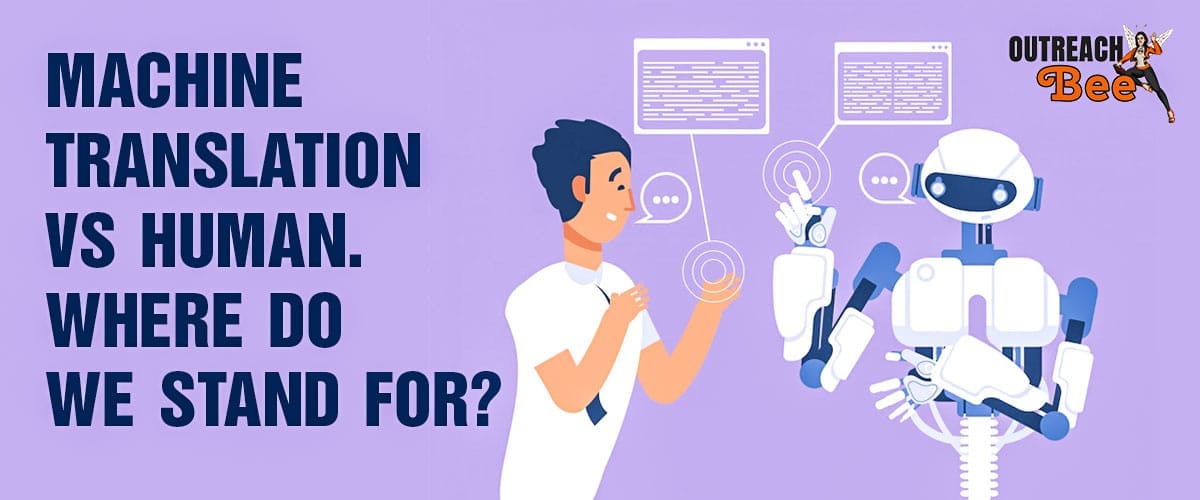Anyone who thinks of machine translation, they probably first think of the legendary Google Translate. However, a lot has happened in this area in recent years.
Machine translation has made huge leaps, especially since the use of artificial intelligence. And with the emergence of really good online translation services, the risk of embarrassing misunderstandings in international email traffic has dropped considerably. But of course, even the best machine translation is nowhere near as good as the human translation version.
How does machine translation (MT) work?
Machine translation – MT for short – is the translation of a text by a computer without human interaction.
There are different types of these machines that have evolved over time:
- Rules-based machine translation
- Example-based machine translation
- Statistical machine translation
- Neural Machine Translation.
In this guide, we will talk a bit more about the last 3 types.
Example-based machine translation
In example-based machine translation, the system uses a translation memory in which entire phrases or idioms are stored. The sentence is then compared to all similar terms in memory and the most frequently matching meaning is chosen for translation.
Statistical Machine Translation
Statistical translators do not use any linguistic rules but instead analyze a huge amount of data from source and target language texts. A dictionary and grammar transfer rules are then derived from this, which are adapted to the respective subject area and the linguistic peculiarities.
These systems “learn” how to translate each time and can be configured for specific industries by expanding them with the required data. Basically, statistical translation systems deliver smoother but less consistent translations that sometimes lack logic.
Neural Machine Translation
Neural machine translation is based on a similar principle but uses artificial intelligence to identify connections between bilingual corpora. For example, an artificial neural network, which recognizes contexts based on the model of our human brain, can predict the probability of a word sequence and thus translate it in real time.
NMT (for short) is, therefore, the most advanced method of automated translation and can deliver results of higher translation quality through independent learning. This technology has been used by leading translation services such as Google Translate, Yandex, and Bing since 2016.
Applications of MT
MTs are now built into our everyday lives without us necessarily realizing it. Whether browsing the internet or social media. Articles and posts are often automatically translated in order to reach the largest possible target group.
Software translation is also used in the customer service of international companies in order to be able to interpret customer inquiries in real time and forward them to the respective department. This avoids waiting times that could annoy the customer and ensures a high quality of service.
In private use, for example, on vacation, you can hardly avoid a translation service or a corresponding app if you are in a foreign-speaking country.
But what about in a professional environment? Translation systems can now also be integrated into common Computer Assisted Translation tools (CAT.) But can those machine programs be used on their own in a business context? This is a question that time alone can answer.
The best translation programs 2022
One of the best freely available online translation tools is Google Translator. The software developed in the US uses artificial intelligence and has thus secured the top position in the market.
Other tools are the still somewhat clumsy. If you only want to translate individual words, the online dictionaries Dict.cc and PONS are ideal. PROMT is also suitable for short sentences.
As an offline translator, and especially when traveling, it is advisable to download a translator app compatible with Android or Apple iOS, such as SayHi or TripLingo.
Man vs. Machine – Can machine replace human translation?
A professional native speaker translates around 2,000 words a day. A computer-based translation program that spits out the result in the target language within seconds is far superior to them. But a machine will probably not be able to learn the human abilities to recognize puns and ambiguities so quickly.
Machine translation problems
When it comes to MT problems, we can mention these:
- First, the independent use of automated translation programs depends on various factors such as the type of text and the purpose of the communication; for demanding target groups such as technical documentation or patent translations for investors or doctors, you should not rely on an MT due to the susceptibility to errors.
- If the translation is purely for understanding or internal use without the intention of publication, MT can be used to save time and resources.
- When it comes to technical translation with technical terms or the translation of manuals, humans are superior to artificial intelligence.
- If creativity is required, for example, when advertising has to be adapted to foreign markets, human knowledge of culture, target groups, and language cannot be replaced.
- A certified translation has so far only been possible by sworn translators and can, therefore, not be replaced by a machine.
Machine thus offers drastic time and cost savings, but human translation is far from redundant.
The future of artificial intelligence in machine translation
Rather, machine translation can move hand in hand with human translators into the future. Whether the significant deficits in the translation of fine language nuances can be overcome by artificial intelligence in the next few years or decades remains to be seen.
Science will certainly insist on continuing to conduct research in this area. Because the advantages in the economy, the military, and international diplomatic understanding are obvious.
In this context, however, the issue of data protection also comes into play. For example, if computer-based programs are used to translate important political documents or personal data, these are susceptible to attacks by hackers or viruses.
How is the security of our data guaranteed when humans no longer have any influence on it? These are all questions that should be asked in the context of machine translation with artificial intelligence.
Conclusion
Machine translation is on the fast track, but it’s far from perfect.
As globalization progresses, more and more (digital) translations are becoming necessary. Hardly any multinational company can do without a multilingual website and customer service. And the costs of a bad translation are often fatal in terms of image, marketing, and customer loyalty.
To avoid this, it makes sense to synergistically use both types of translation. We can continue to be excited to see what research about artificial intelligence has in store for us in the coming years and how this will enrich our work in the international field.



What is a DNS, and Why Do You Need One?
In Need of a Good VPN? Here is a List Based on Reliability, Speed, and Security